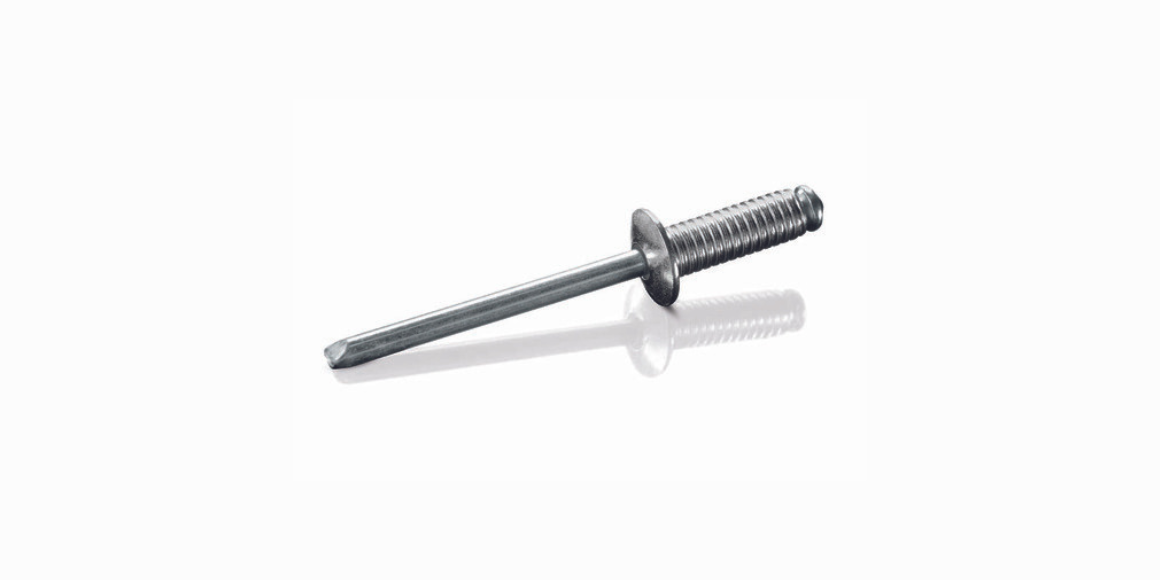
Blind rivets are a category of fastener that encompasses various designs beyond the simple pop rivets. Most blind rivets have a two-piece design with a rivet body and a mandrel insert. They are commonly used in manufacturing, HVAC, boat building, construction, and any application where you must fasten two materials together but only have access to one side. The ability to set a rivet without access to the back—or blind side—is where the term blind rivet derives from.
You set a blind rivet by pulling the mandrel into the rivet shaft, which collapses the rivet on the blind side to make the joint. But not all blind rivets are the same. They come in different designs, sizes, and materials for various applications, including grooved blind rivets, a unique subset with specialty applications.
A Different Blind Rivet Design
Grooved blind rivets have a unique design for unique applications, which sets them apart from other blind rivets. Blind Rivet bodies are typically smooth so you can easily insert them into pre-drilled holes. A grooved blind rivet has ridges on the body, making it more difficult to pull out.
You set all blind rivets by pulling the mandrel. With standard blind rivets, the blind side collapses to form a firm bind. With grooved blind rivets, pulling the mandrel expands the rivet body, securing it in the hole with outward pressure. Grooved blind rivets must have a tight fit in the pre-drilled hole for a proper, lasting fit.
Grooved blind rivets are most useful in applications where the joint must withstand strong vibrations or risk of pullout. Grooved rivets are often used in soft materials, such as plastics or wood, where the outward pressure works well to create a firm bond.
There are many applications for grooved blind rivets:
- Wooden furniture makers often use grooved blind rivets because they are stronger than other fasteners and resist pullouts.
- Grooved blind rivets are used instead of screws or bolts since they are strong but tamperproof. For example, they can be used in public restrooms to install stalls, bolts, or external door locks.
- Soft plastic materials can be joined using blind rivets since the outward pressure of the rivet creates a strong bond.
- Grooved blind rivets are often used in construction to connect plastics or metals to wood or fibrous materials.
Choose the Right Specifications
While there is one basic design of grooved blind rivets, differences in length, diameter, head type, grip range, and so on can make it challenging to choose the right grooved rivet for any job.
Diameter
The diameter of the grooved rivet relates to how the rivet fits into a pre-drilled hole. For a strong joint, the fit must be tight so the grooves can exert sufficient pressure on the sides of the hole.
Head Type
As with all blind rivets, grooved blind rivets come with different head types. The most common type is the dome head, which delivers a finished look.
Grip Range
The grip range is the length of the rivet, which needs to match the thickness of the materials. There is a minimum and maximum grip range, but the maximum grip range isn’t the length of the rivet but rather the width of the fastened materials. If the grip range is too long, the rivet won’t have a clean fit, and the head or end of the rivet will protrude.
Using too short a grip range will mean the joint won’t be as strong since it won’t provide a complete grip inside the holes. When considering whether to use a grooved blind rivet, remember that the material needs to be thick enough to handle the grip.
Material
The rivet material should match the materials being joined. As a rule, the rivets should be harder than the materials being joined. Suppose you are using blind grooved rivets with soft materials, such as wood. Due to normal wear and tear, the rivet materials need to be strong enough to maintain a strong bond without loosening.
There are other considerations as well. For example, aluminum rivets are lighter, so they are ideal for applications such as aircraft manufacturing, and copper-nickel rivets resist corrosion.
Tensile and Shear Strength
Tensile strength is the maximum stress a blind rivet can handle along its length. Shear strength is the amount of lateral stress a rivet can tolerate before it bends or breaks. For grooved blind rivets, the tensile and shear strength must be sufficient for the application so the fastener won’t fail over time.
It requires the same steps to install grooved blind rivets as it does to install any other blind rivet. The rivet tool pulls the mandrel, which expands the grooved rivet in the hole. The pressure the rivet exerts against the sides of the hole holds it in place. The mandrel is then removed for a clean finish.
Find Grooved Blind Rivets Online
Goebel is the biggest manufacturer of grooved blind rivets available in the U.S., and Bay Supply offers a complete catalog of Goebel grooved blind rivets. Goebel grooved fasteners range from the ABS-43-GR aluminum rivet with a 0.125-inch diameter and a 0.236-inch grip range to the ABS-69-GR aluminum rivet with a 0.187-inch diameter and a 0.591-inch grip range.
The Bay Supply Marketplace offers a complete catalog of blind rivets from global fastener manufacturers, including grooved blind rivets. If you haven’t already signed up, it’s the ideal online destination to match fastener manufacturers and distributors with customers. Set up your account today to find the fasteners you need for your next job. And you can learn more by reading The Essential Guide to Blind Rivets.




Comments